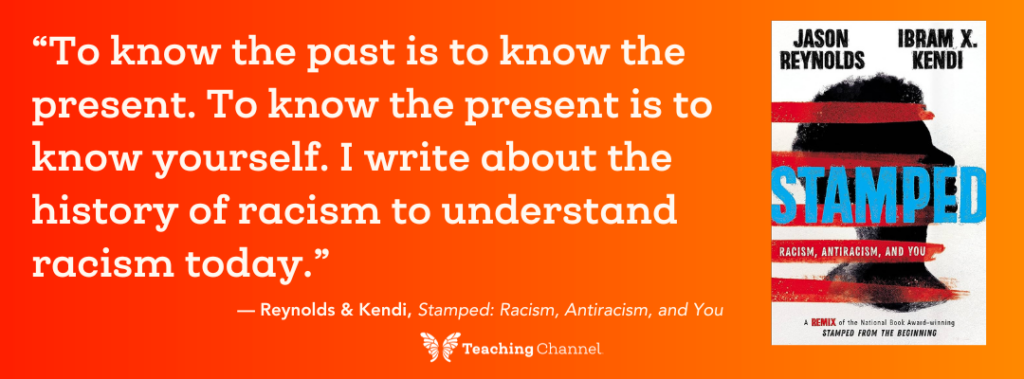If you had asked me as a high schooler what the purpose of social studies class was, I would have peeked at you from behind my early-2000’s side-swept bangs and said, “it’s a class where you memorize stuff.” Read a chapter in a book, write down the list of important people, events, and dates in my notebook, and take a quiz about them. It kind of felt like the instructions on a shampoo bottle:
Read
Memorize &
Repeat.
But everything I memorized seemed to disappear as soon as the test was done. And, over time, all of the facts and figures started blending together until they felt hollow—disembodied events that had no meaning beyond a grade.
If only I had known that rooted within history is the story. And not just the paragraph written in the textbook focused on the who, what, when, and where. But the story about the why. The story about the people whose lives were impacted by each historical event, the real reasons why they went to war, the conversations they had behind closed doors and in hushed voices that never found a home in the history books. As a high school student, I yearned for the stories of the young people throughout history who—like me—were impacted by decisions made by the adults in the room, who resisted quietly (and loudly!), who had to navigate the ramifications and the long-term impacts and somehow find a way to hope, dream, and changemake in spite of their circumstances.
Somehow the phrase, “in 1492, Columbus sailed the ocean blue” never quite captured all of the nuance and complexity of his arrival.
But how do we transform social studies lessons into opportunities to investigate the stories within important historical events? Here are 5 activities to make history come alive for your students:
1. In Conversation
Ask students to select two historical figures they are learning about in their classes, and imagine they are having a conversation with one another. If they are from the same historical event, what would they have talked about? If they are from different historical events/time periods, what ideals or beliefs would they have agreed or disagreed on? Consider using this “In Conversation Writing Template” to organize student ideas.
2. Past and Present Connections
Invite students to make connections between your current social studies unit and the world today! Provide opportunities to explore student news resources like The Learning Network from the New York Times to identify patterns between the past and present.
3. Perspective Writing
Use this “Perspective Writing Template” to help students process through the complex and multidimensional aspects of history. For example: how would a Union soldier, a Confederate soldier, Harriet Tubman, and a slave living in the south during the war think, feel, or talk about the Civil War?
4. Philosophical Chairs
Discuss and reflect on big ideas in your social studies class using Philosophical Chairs! Review the protocol in “A Framework for Whole-Class Discussions,” by Jill Fletcher from Edutopia, and consider how you could develop a high-engagement, two-sided prompt related to your current unit of study.
5. Young Readers’ Editions of Texts
Use a Young Readers’ Edition of a historical text to examine history beyond the traditional textbook. Packed full of stories about real people, these books can bring history to life with their powerful storytelling and beautiful prose. One or our personal favorites? Stamped: Racism Antiracism, and You, by Ibram X. Kendi & Jason Reynolds! Kendi and Reynolds walk readers through the history of racism in the United States and the complex—sometimes contradictory—perspectives of many important historical figures.

I wonder what my high school self would have thought about learning U.S. history beyond the rote memorization of facts through the use of storytelling, philosophical discussions, and perspective writing. I think I would have realized much sooner that history is alive and breathing, and while I originally thought the formula for success in social studies was:
Read
Memorize &
Repeat
What I really should have been focused on were the ways:
History will
Repeat until
We
Learn from it.
Now THAT would have been a shampoo worth buying (my side-swept bangs agree)!
Ready to take your history instruction beyond the textbook and into the world of Stamped: Racism, Antiracism, and You? Check out 5330: Beyond the Book: Creating a Comprehensive Unit for Stamped! This debut course in our brand-new Beyond the Book Series provides all the tools you need to design and develop a unit of study to implement in your secondary classroom. With more than 30 instructional activities and resources woven throughout, you will create dynamic lessons to tell the stories that live within social studies, and make history come alive for your students!
About the Author

Julie Kuntz holds a B.A. in English and a Master’s in Education. Drawing on her years as a Middle School ELA Teacher, Julie develops content that is practical and highly engaging! Additionally, she is passionate about fostering equity in schools.
Fun Fact: Julie and her husband own a custom home renovation company, Custom by Kuntz!






